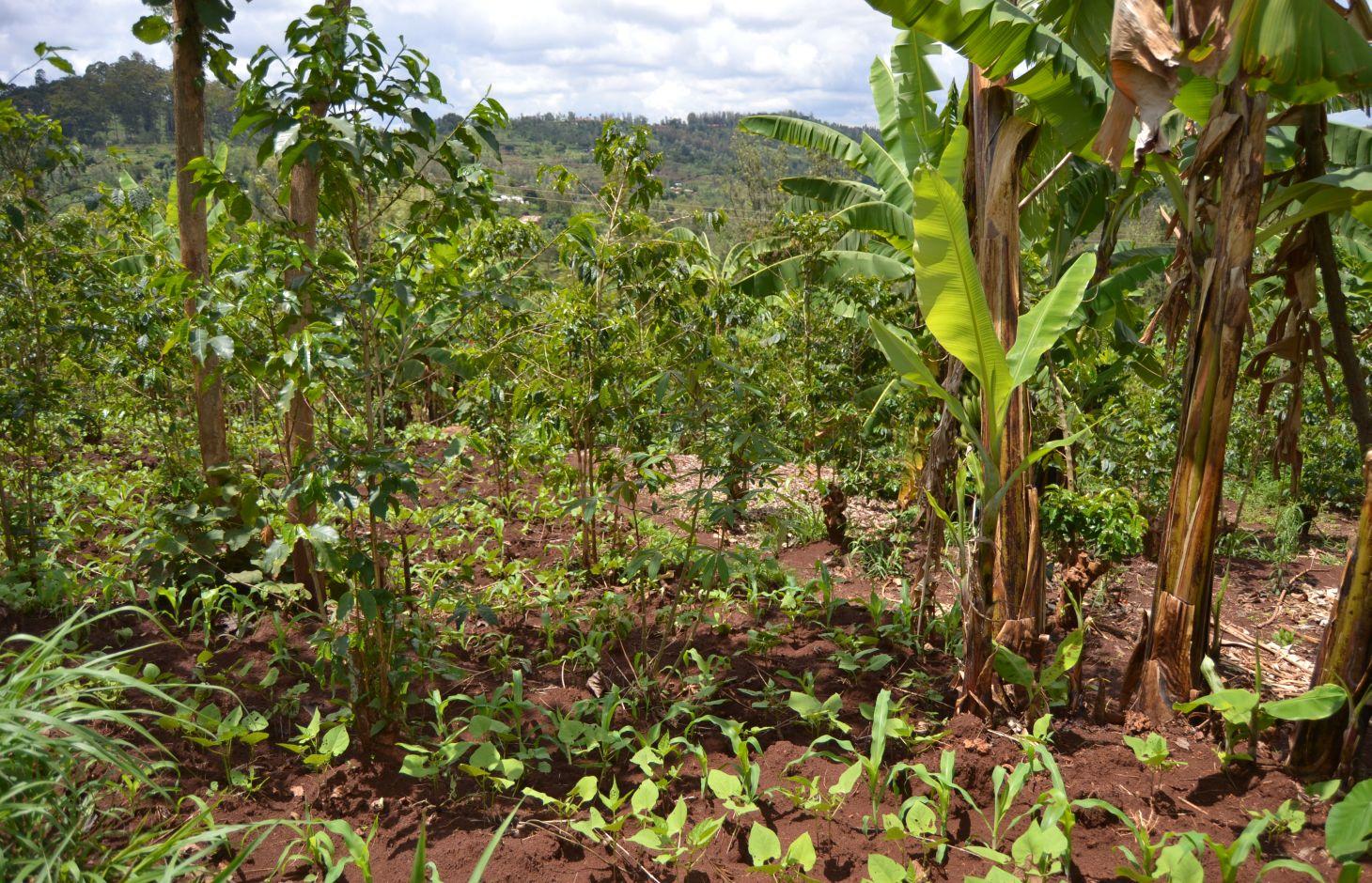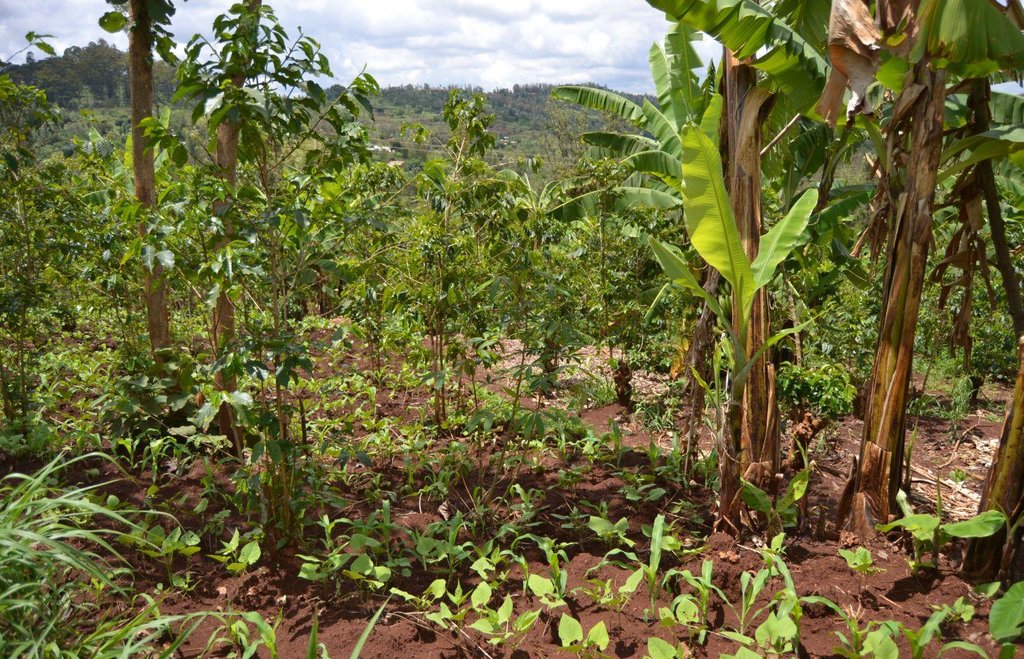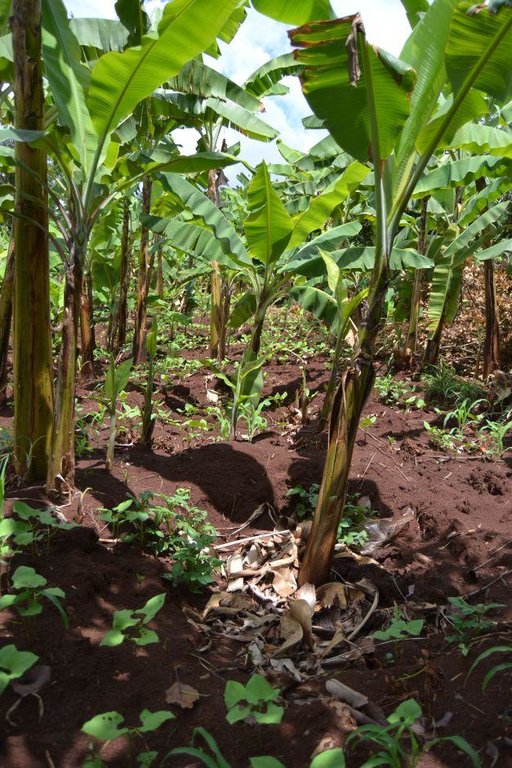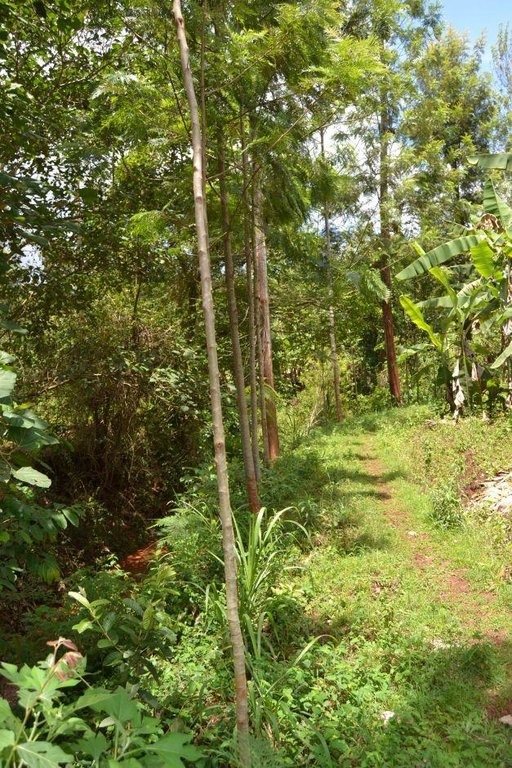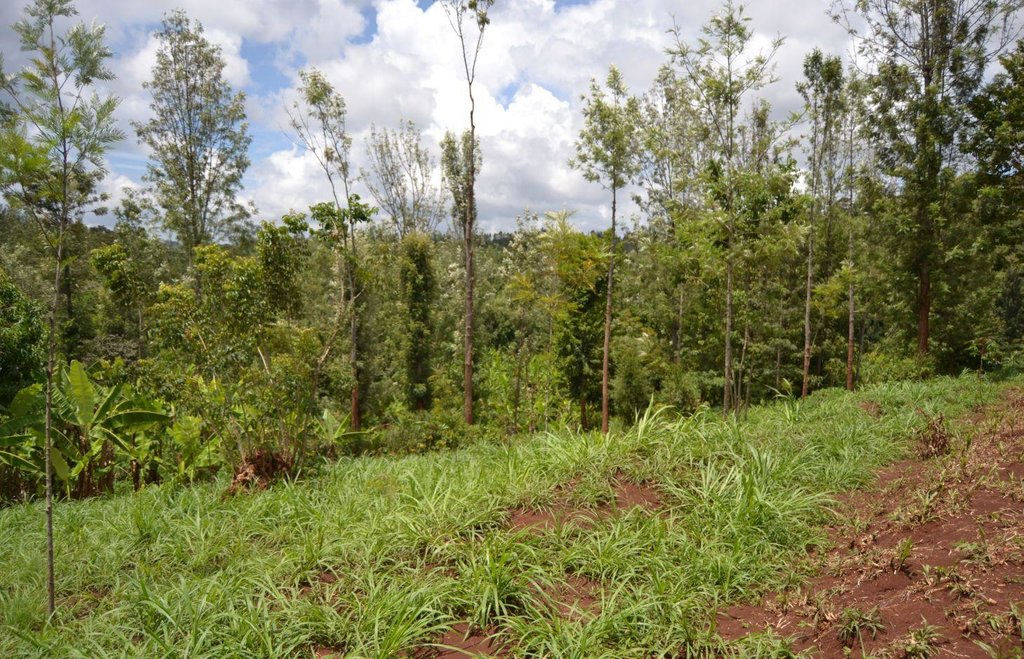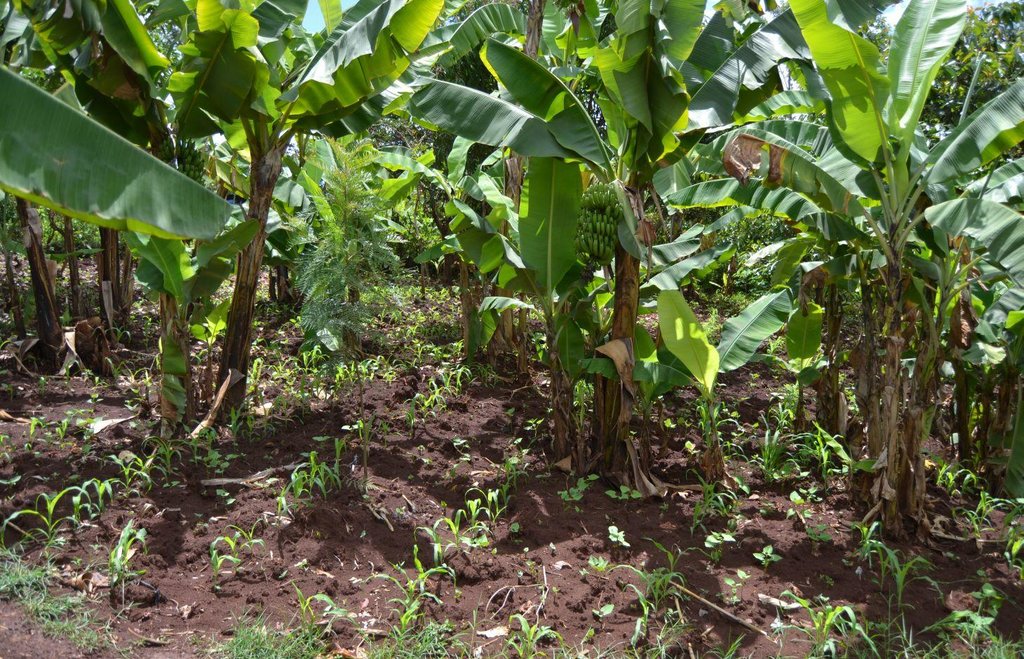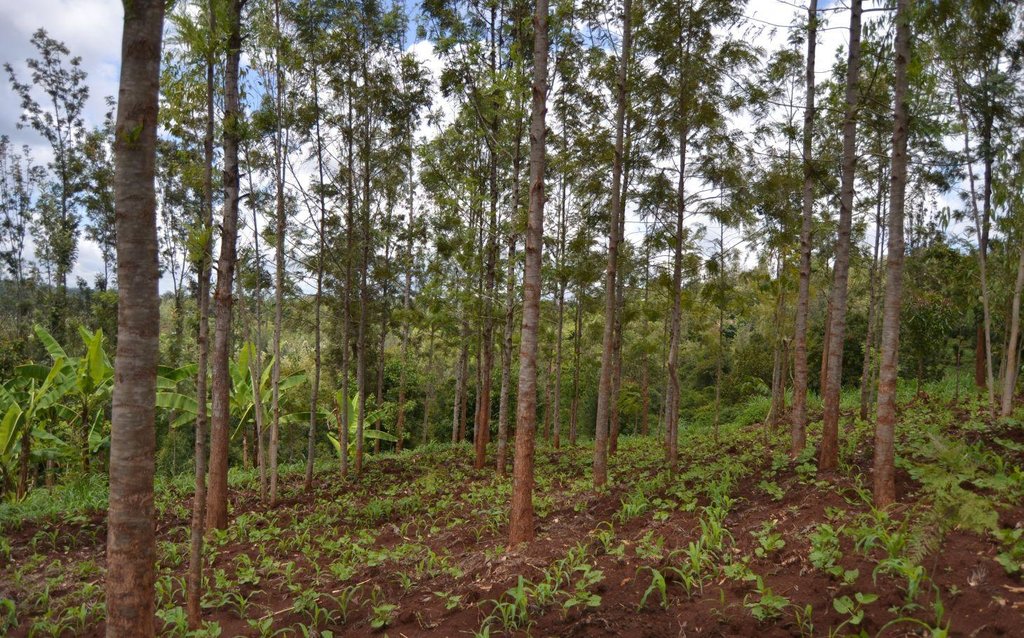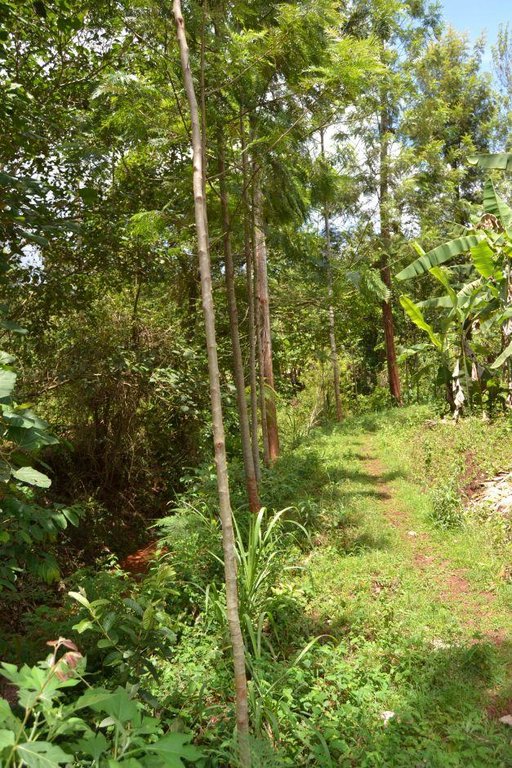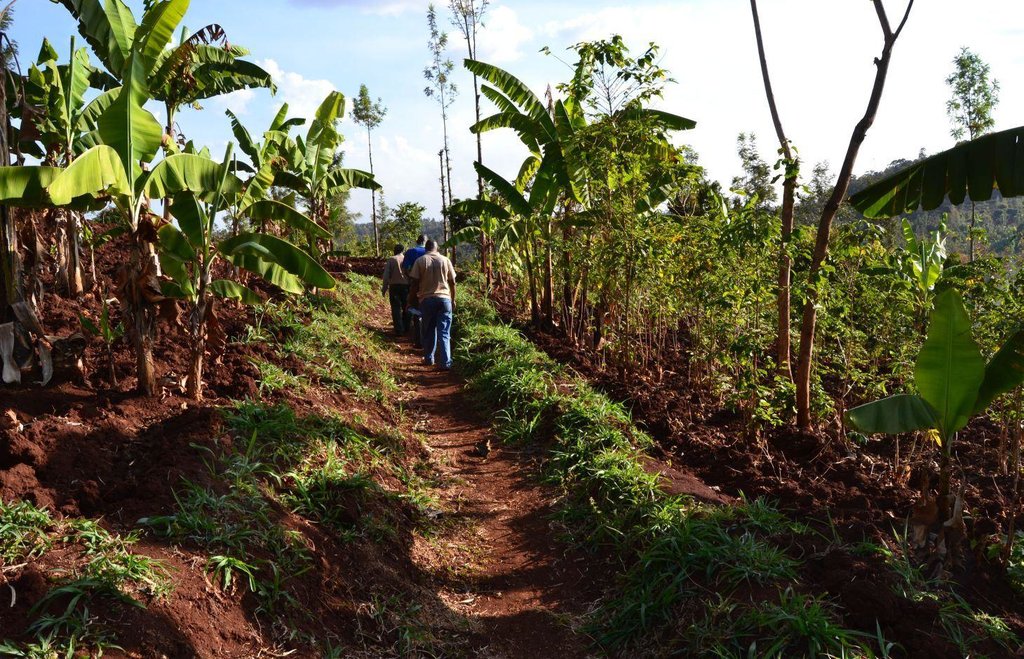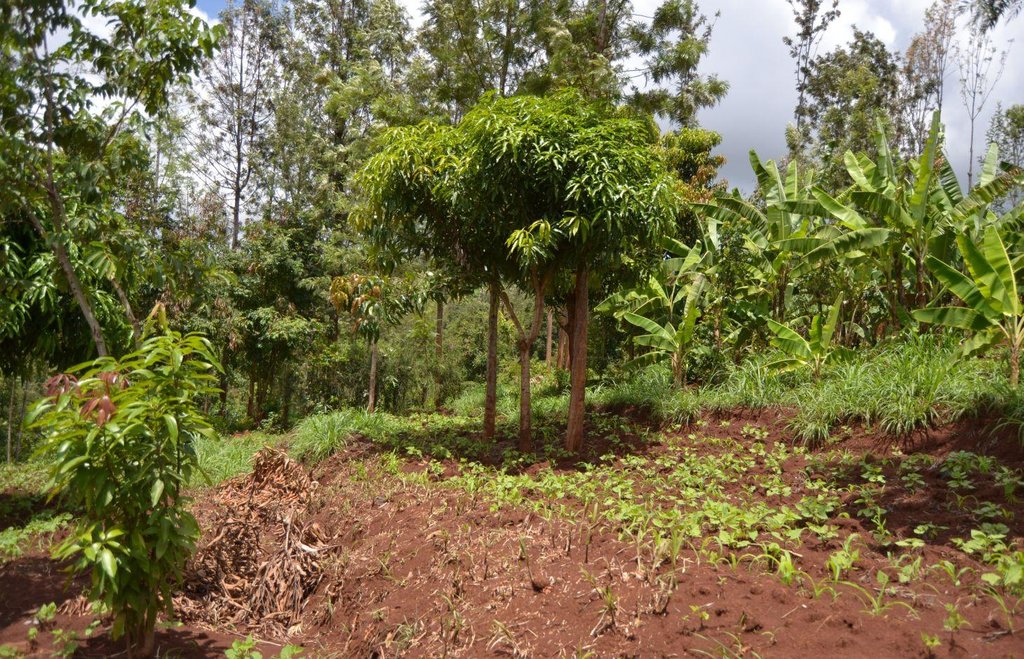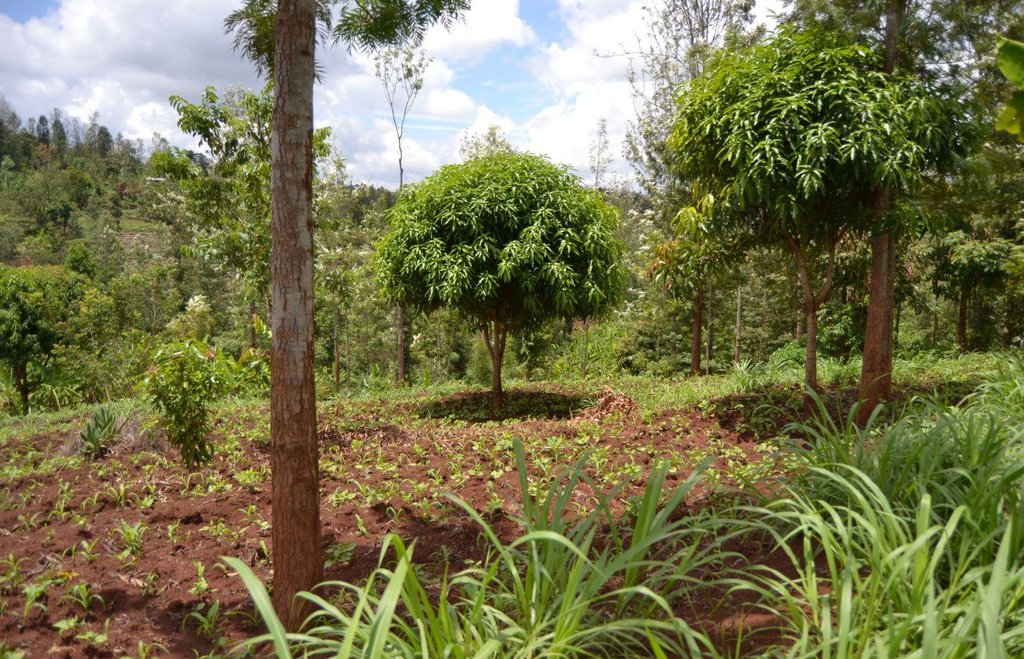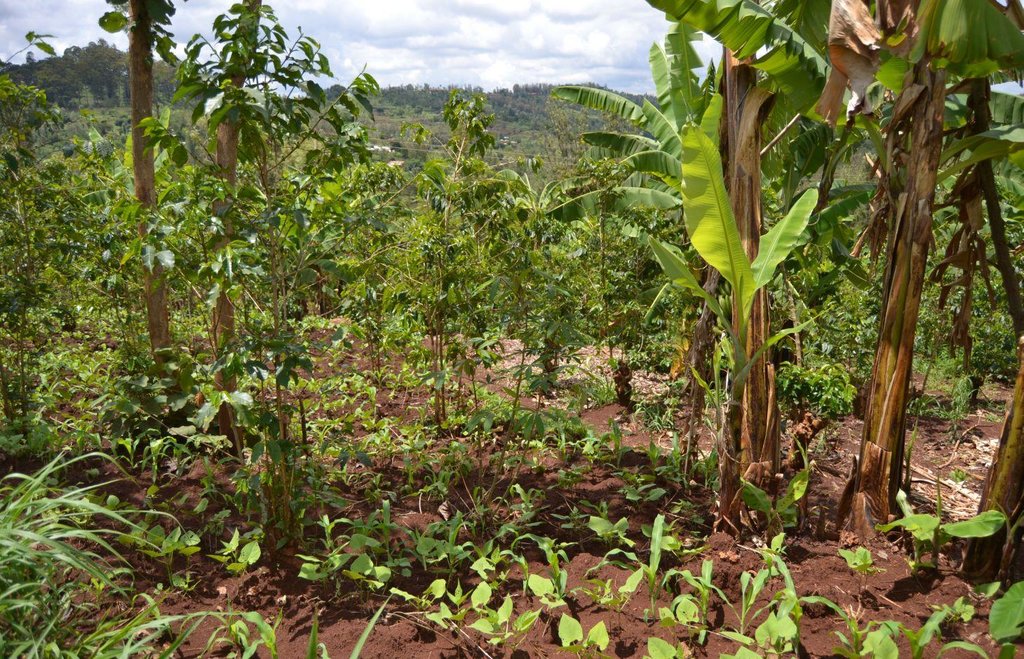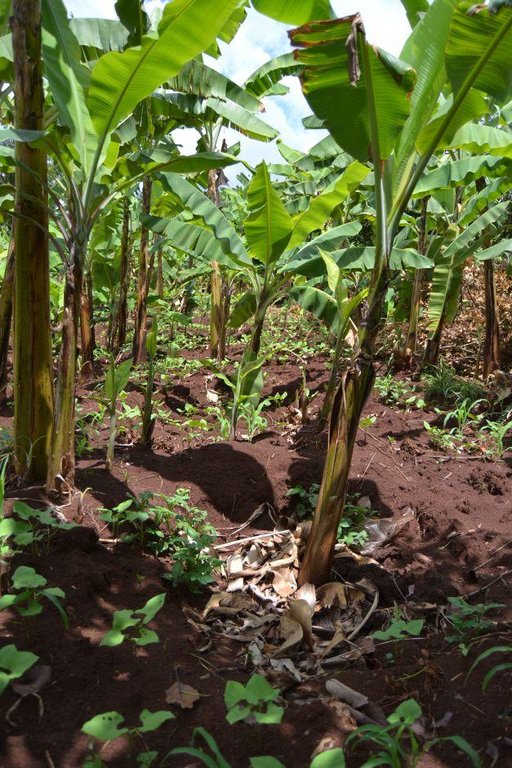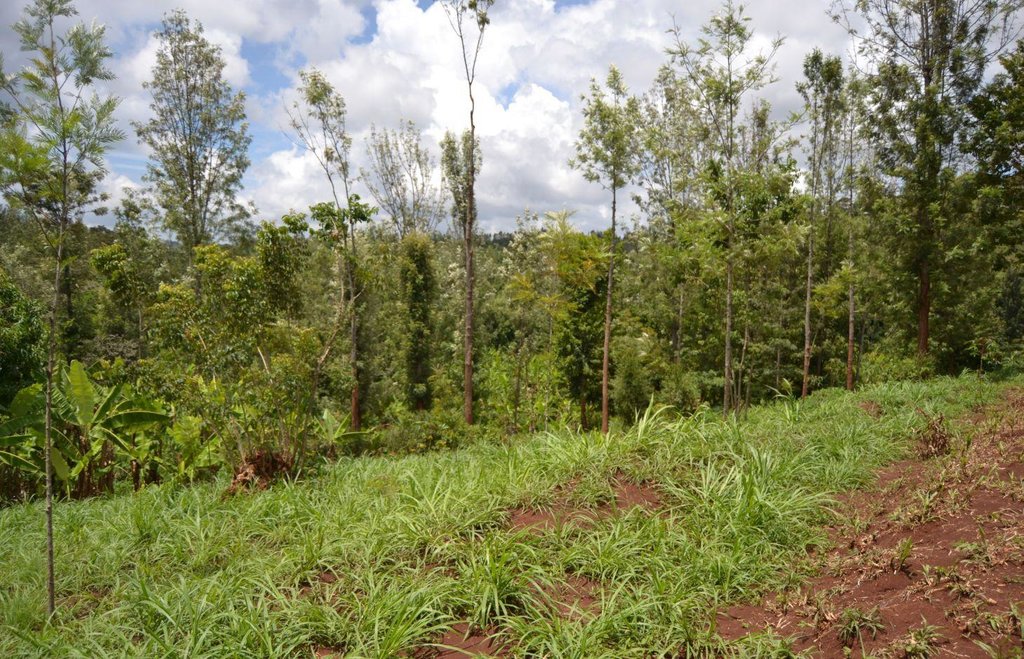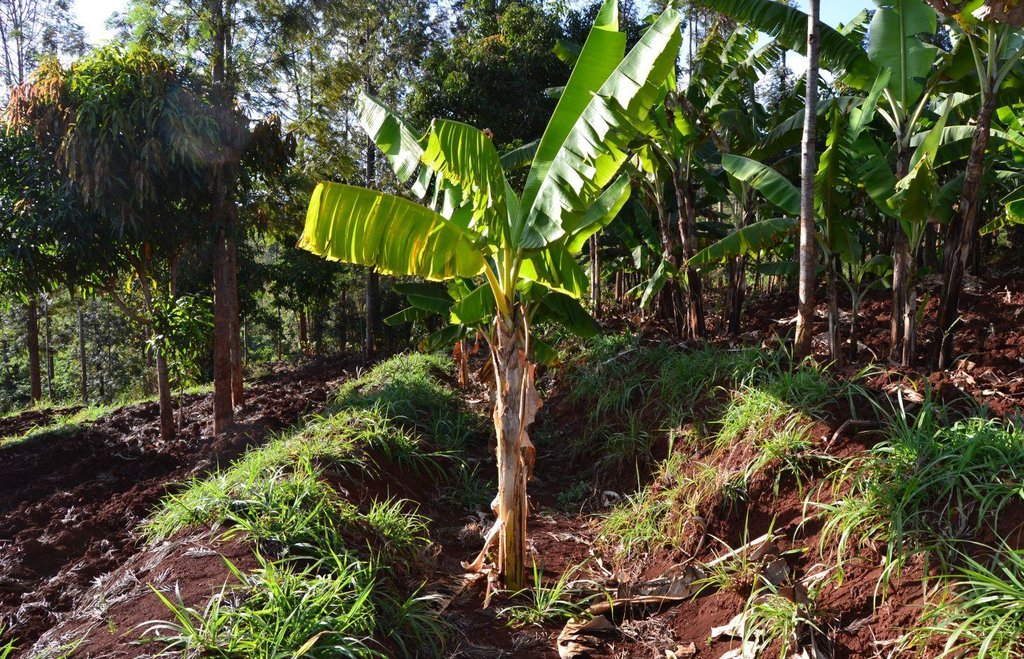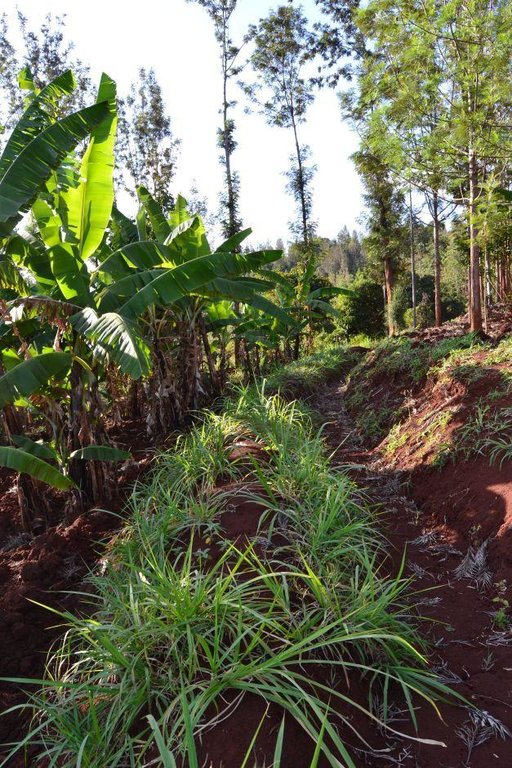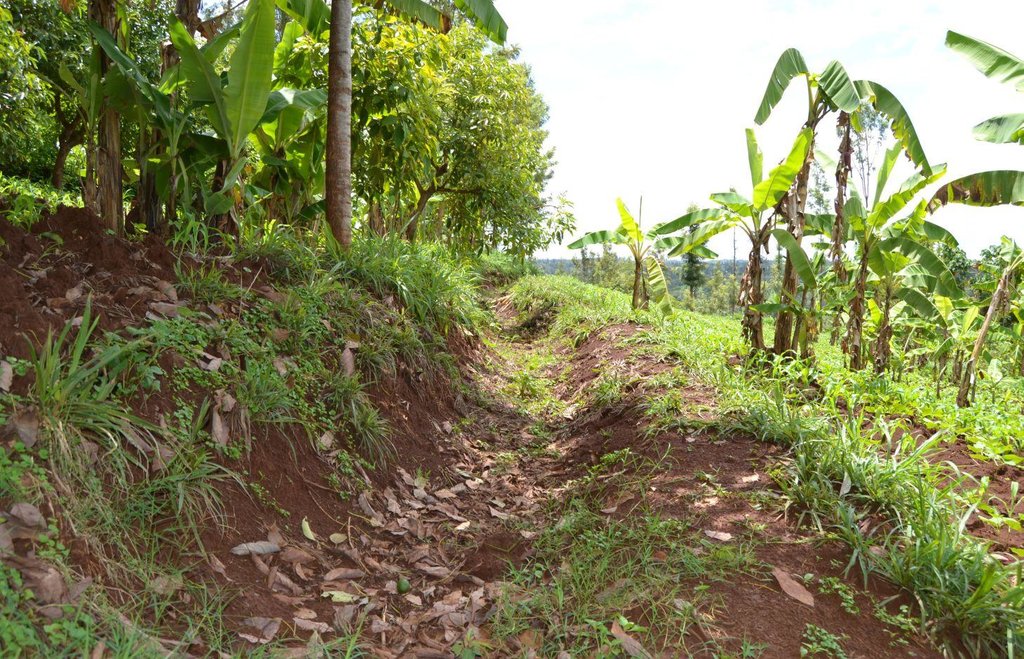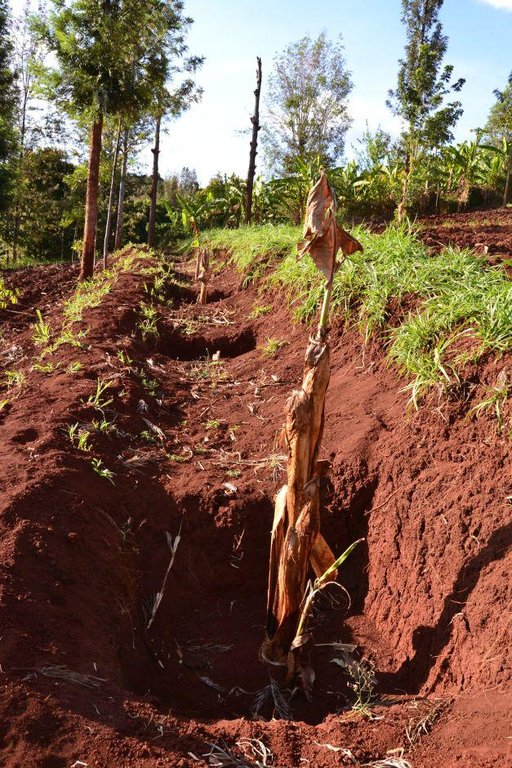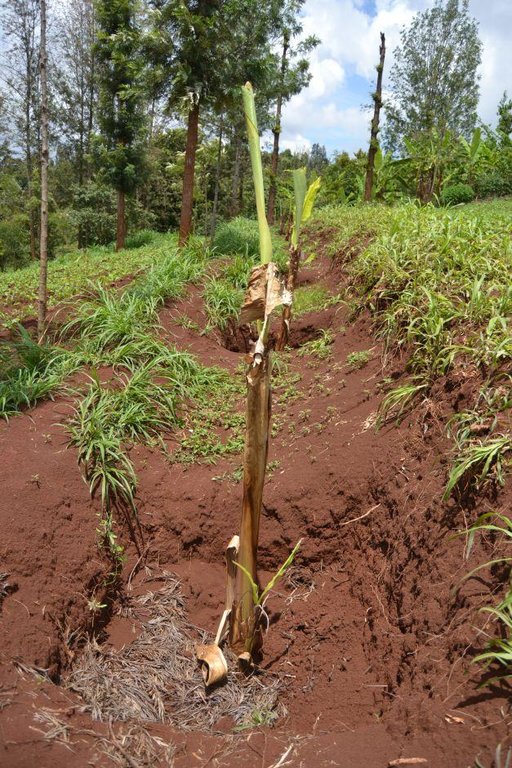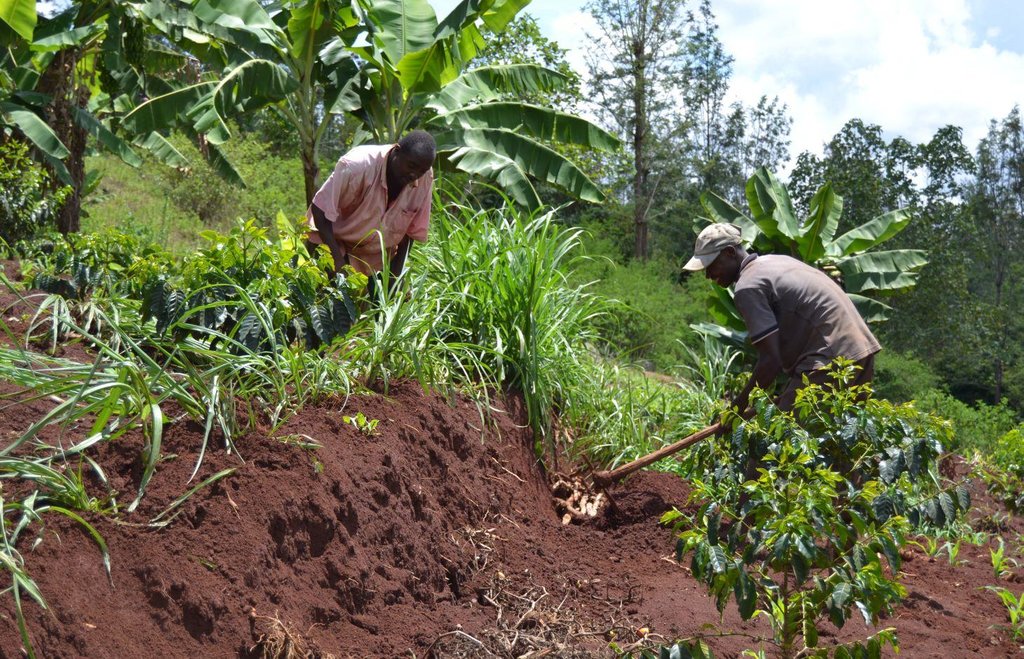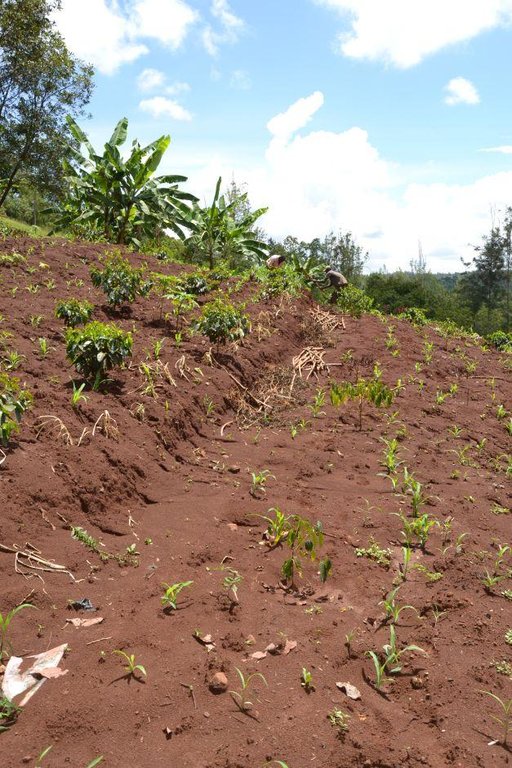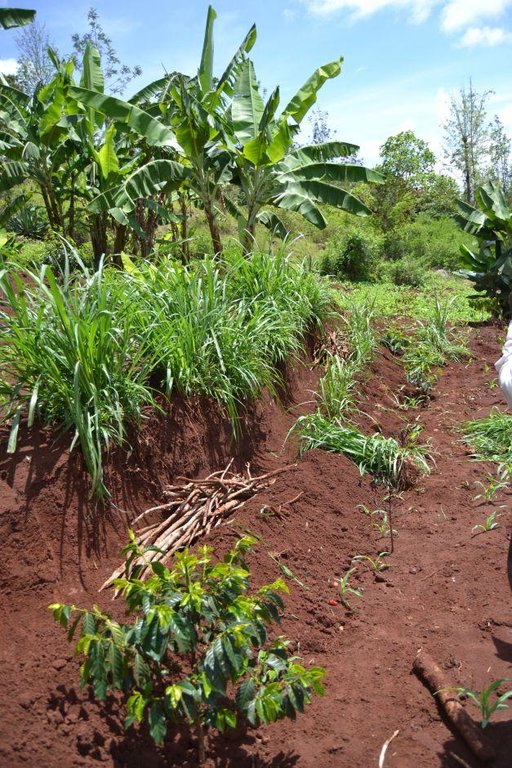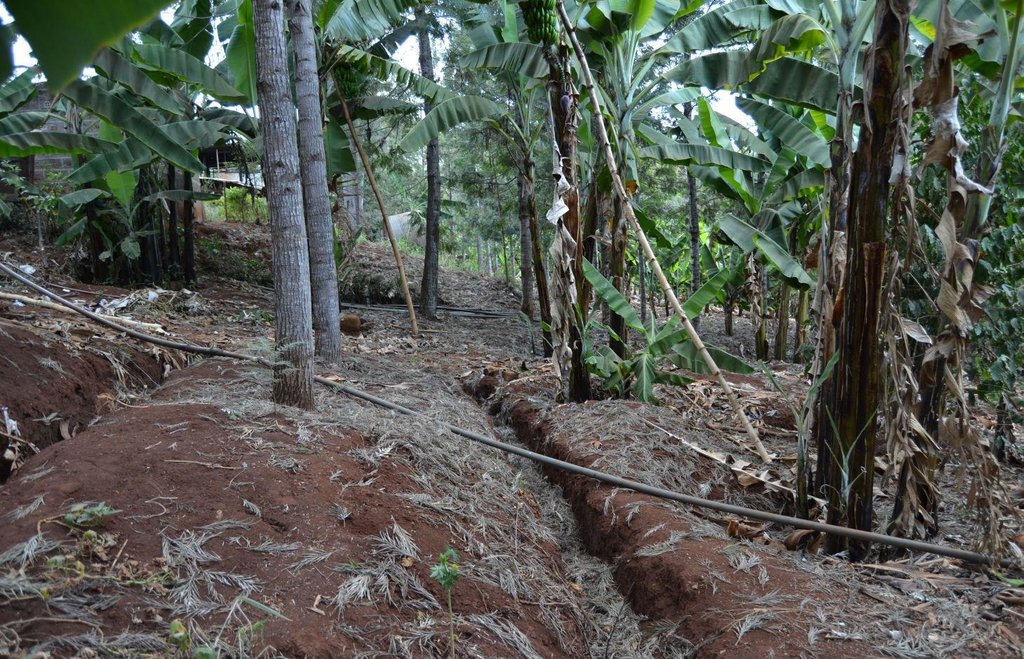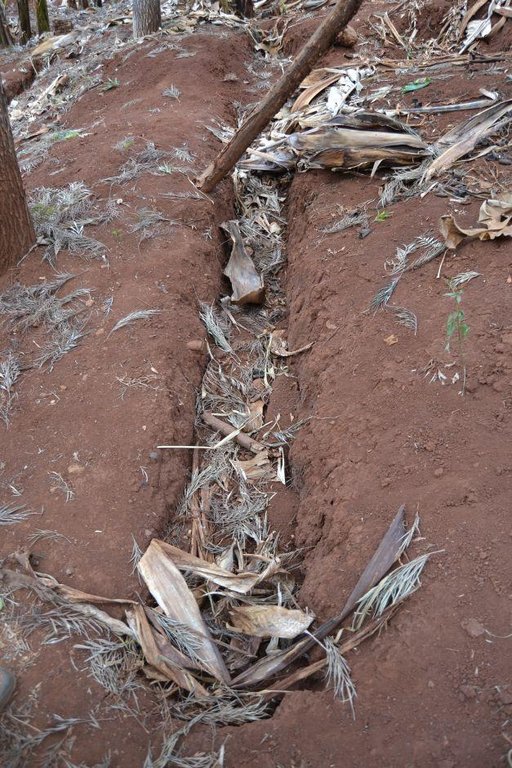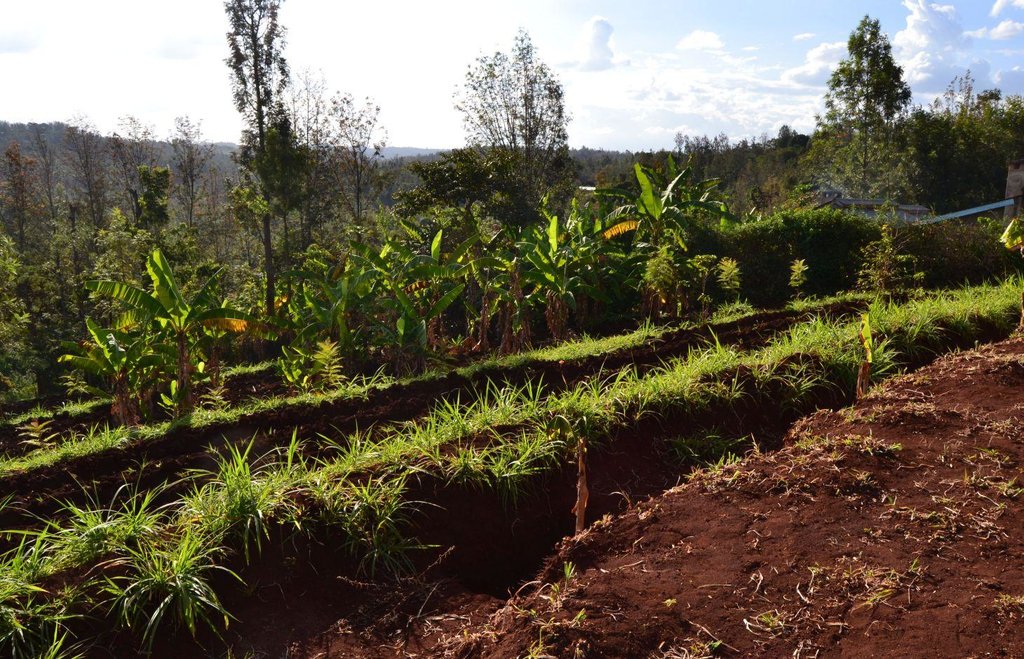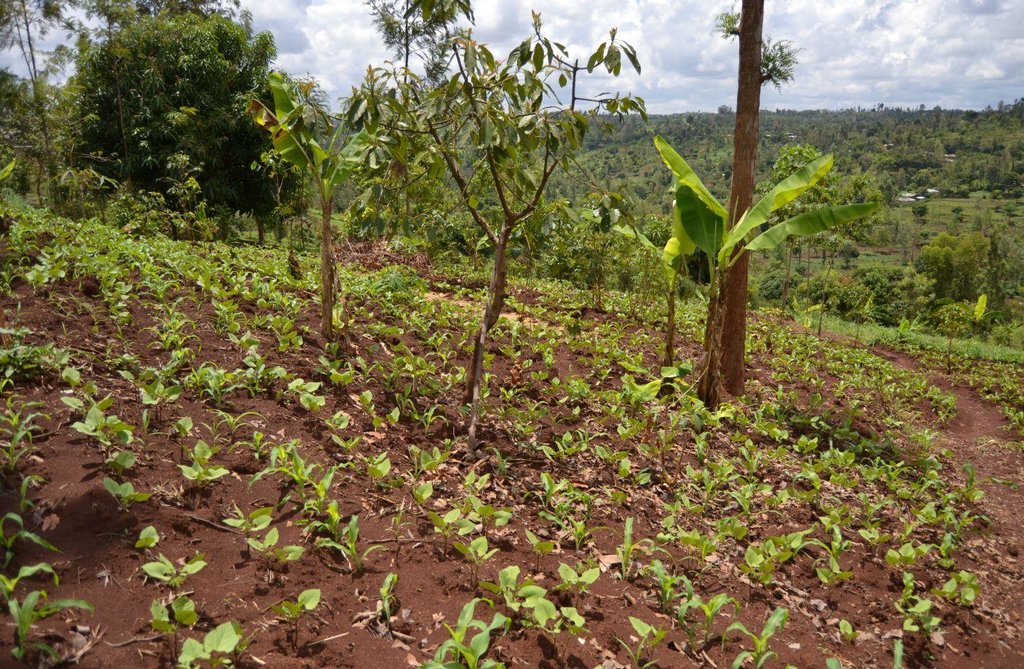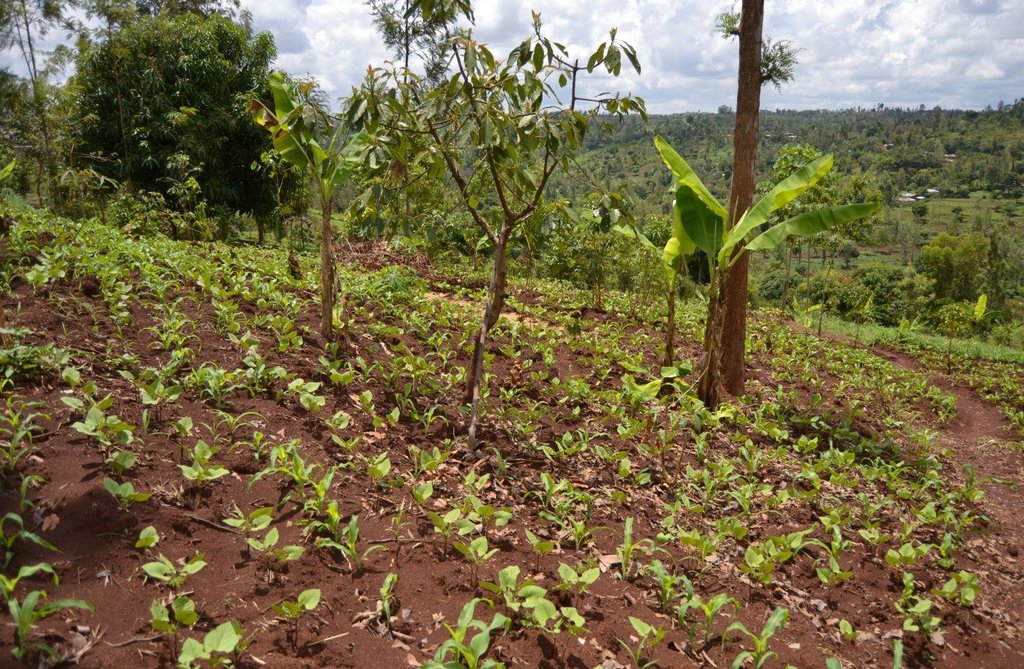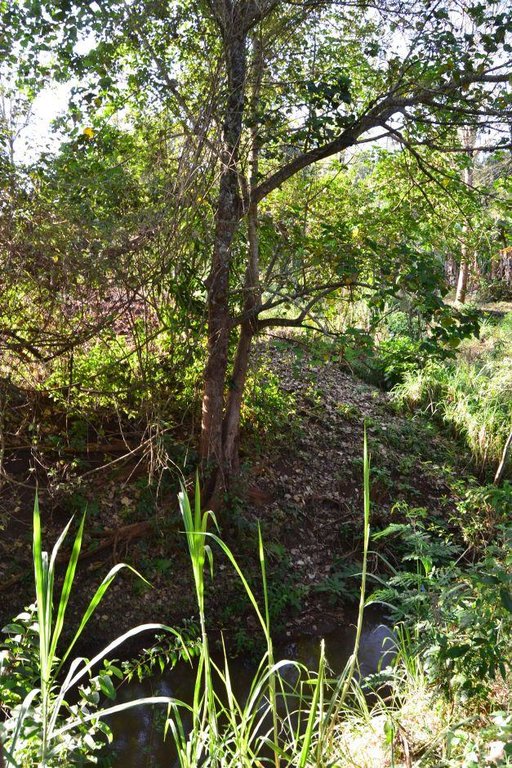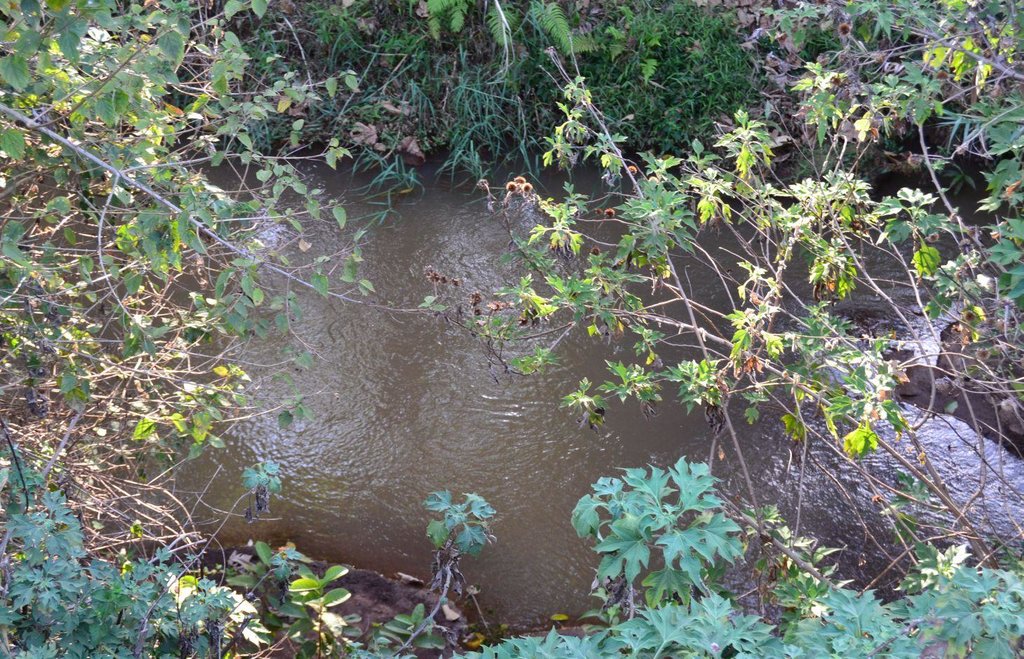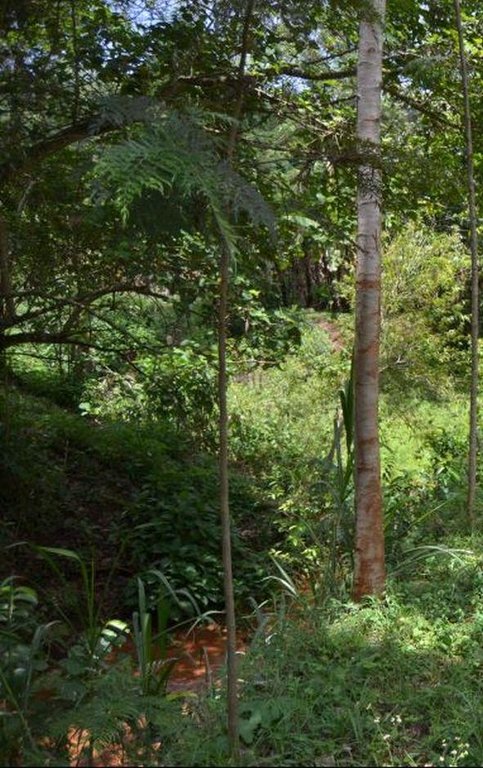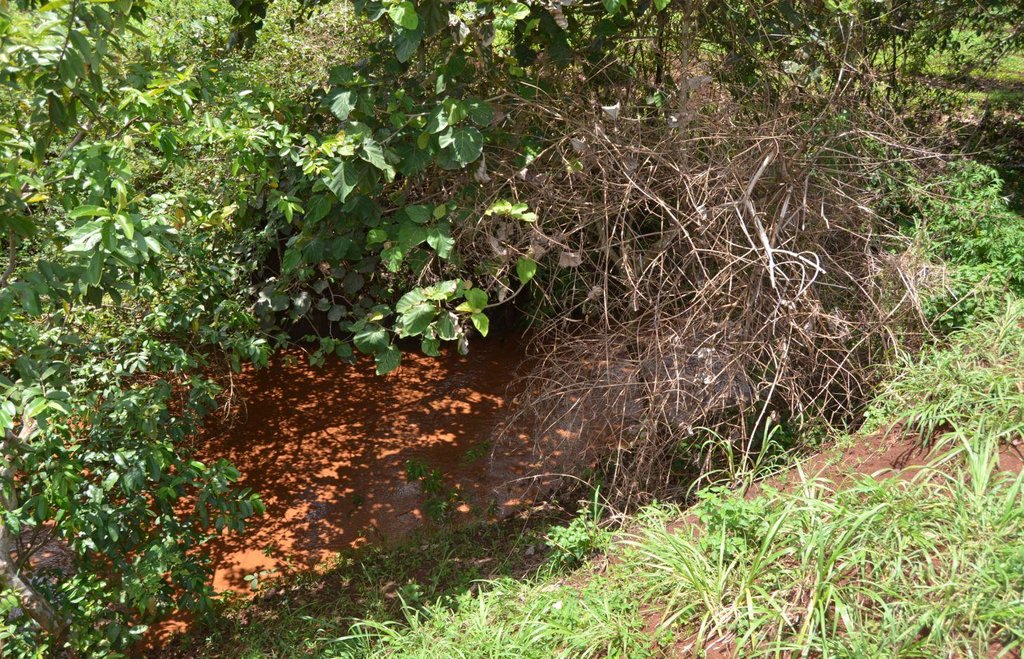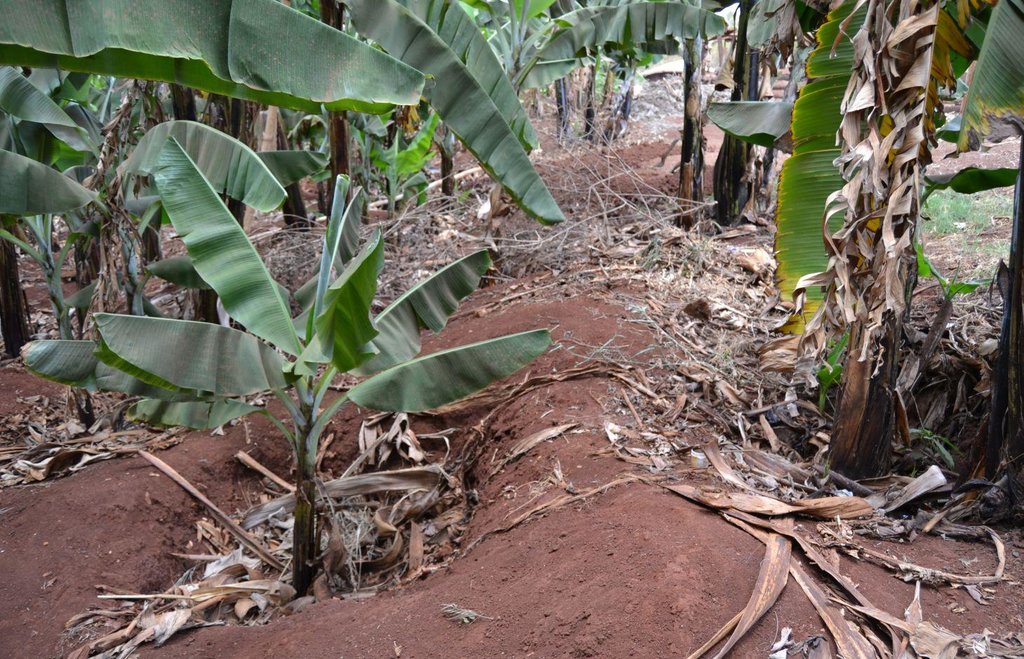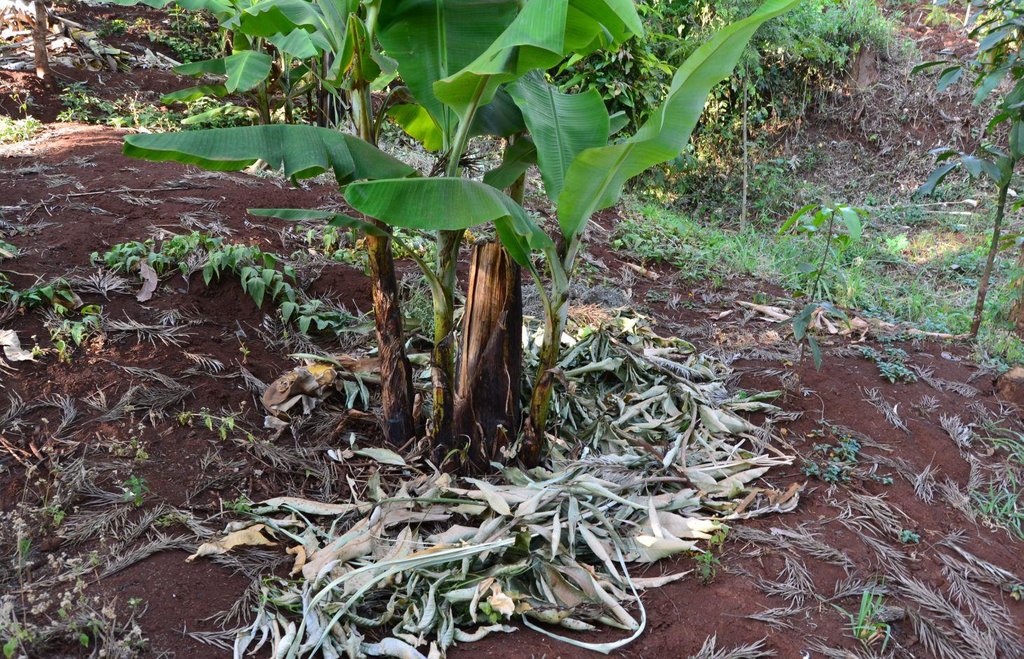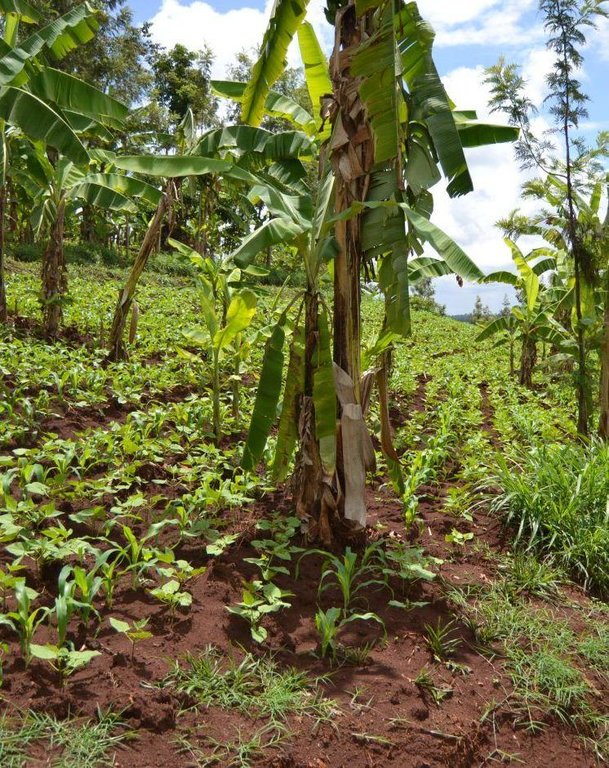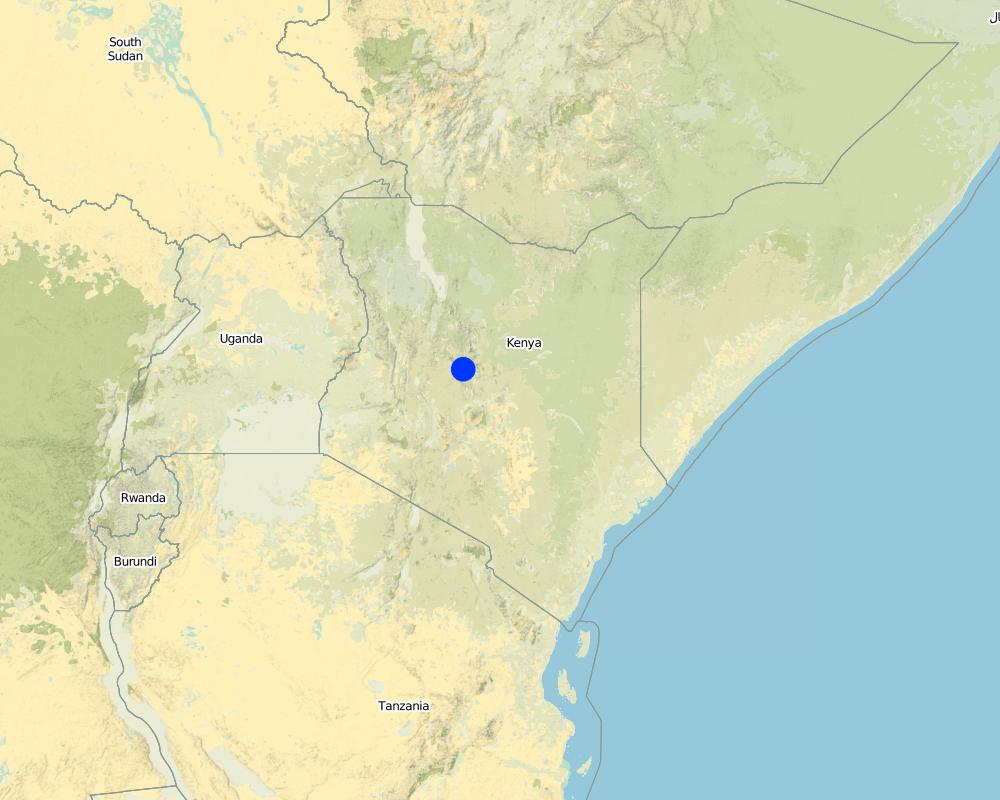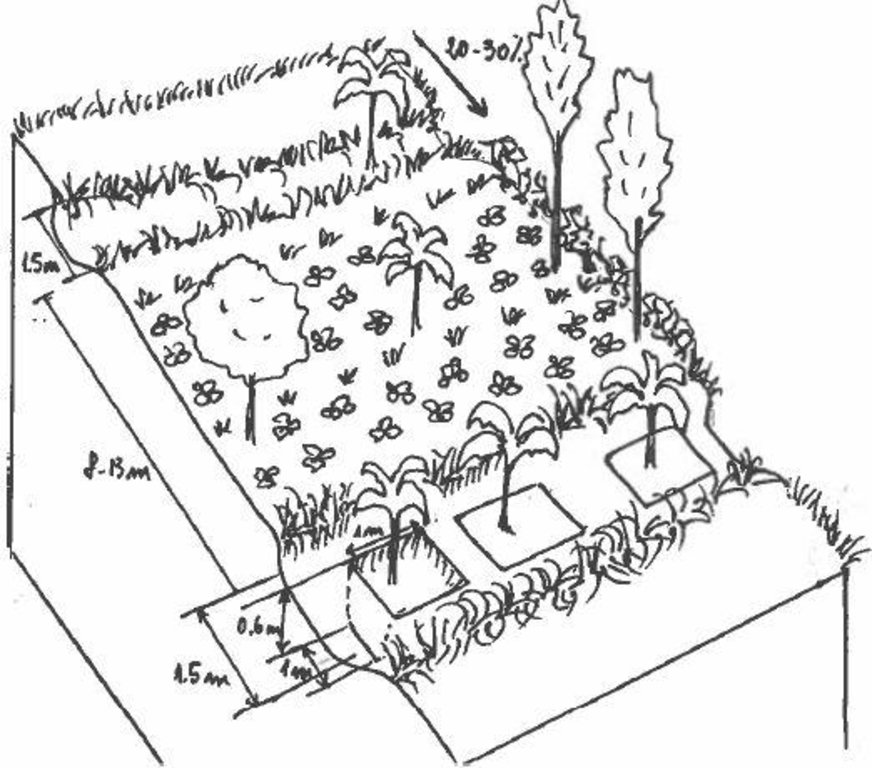Agroforestry land use in bench terraces with cut-off and infiltration ditches and Napier grass strips. [Quênia]
- Criação:
- Atualização:
- Compilador/a: Laura D'Aietti
- Editor: –
- Revisores: Alexandra Gavilano, Fabian Ottiger
technologies_1159 - Quênia
- Resumo completo em PDF
- Resumo completo em PDF para impressão
- Resumo completo no navegador
- Resumo completo (sem formatação)
- Agroforestry land use in bench terraces with cut-off and infiltration ditches and Napier grass strips.: 29 de Dezembro de 2016 (inactive)
- Agroforestry land use in bench terraces with cut-off and infiltration ditches and Napier grass strips.: 5 de Junho de 2017 (inactive)
- Agroforestry land use in bench terraces with cut-off and infiltration ditches and Napier grass strips.: 3 de Maio de 2019 (public)
Veja as seções
Expandir tudo Recolher tudo1. Informação geral
1.2 Detalhes do contato das pessoas capacitadas e instituições envolvidas na avaliação e documentação da tecnologia
Pessoa(s) capacitada(s)
Especialista em GST:
F. K. Nyamu Jospeh
WRUA Sabasaba
Quênia
Nome da(s) instituição(ões) que facilitou(ram) a documentação/ avaliação da Tecnologia (se relevante)
FAO Food and Agriculture Organization (FAO Food and Agriculture Organization) - Itália1.3 Condições em relação ao uso da informação documentada através de WOCAT
Quando os dados foram compilados (no campo)?
02/11/2012
O compilador e a(s) pessoa(s) capacitada(s) aceitam as condições relativas ao uso de dados documentados através do WOCAT:
Sim
2. Descrição da tecnologia de GST
2.1 Descrição curta da tecnologia
Definição da tecnologia:
A combination of agricultural (e.g. intercropping, mulching, minimum tillage), vegetative (e.g. Napier grass strips, trees planting) and structural (e.g. ditches, bench terracing) measures which aim to maximise the overall yield in a sustainable manner (e.g. reduction of soil erosion and increasing the soil quality).
2.2 Descrição detalhada da tecnologia
Descrição:
The land of the farmer is of 3 acres: 2 acres to plant maize (Zea mays) intercropped with beans (Phaseolus vulgaris) in combination with several trees species: Mangoes, Avocadoes, Bananas, Grevillea and Makadamia and half acre for coffee plantation with Bananas and half with Napier grass production for fodder (to feed cows). To increase and fasten the grass growth, manure is applied twice a year, before the rainy season (around February and September), while mulching is practiced under Banana trees every season. Minimum tillage is applied to reduce soil disturbance and to increase water use efficiency by minimizing direct evaporation, increasing infiltration and water recharge (Liniger, 1991) especially during dry seasons, which results in better crop yields.
For timber production Grevillea trees are planted scattered overall the land and on the edge of the river for demarcation (environmental role in stabilizing the soil against erosive forces).
Concerning the structural measures, the farmer constructed has built 14 bench terraces, six of them were designed to plant cash crops (coffee); each terrace is characterized by a ditch to cut off the drainage and collect water and nutrients; they are also used as paths to facilitate transportation and farm operations. Ditches are both drainage and infiltration types and are excavated along the contour.
Purpose of the Technology: Beans and maize are cultivated for home consumption but partially (about 20%-4 bags of maize and half bag of beans) also for commercial purposes. Coffee is harvested twice a year, with a production of about 500 kg per season; the coffee is sold at 45 Kenyan Shillings (KSh) per kg (SL-28-arabica varieties). Indeed, the farmer is interested in cultivating the certified and improved variety called Ruiru 11 which is generally disease resistant, easy to maintain (less expensive) with a modest risk of pests (according to the farmer). Grevillea timber is sold twice a year, only trees of 1.5 feet in diameter (about 45 cm), at about 80 KSh per feet. Beside the commercial role of Grevillea, when sufficiently grown these trees lead to a reduction of the wind speed, protect the intercrops and provide mulching material to be used over banana trees. The deep roots of mature Grevillea are not in competition with the crops for soil and water, instead they enhance infiltration (Otengi, 2007). Makadamia will be used to produce cooking oil, while bananas, avocados and mangoes are fruits collected for the local markets. Napier grass is cultivated to stabilize the ditches and for fodder production.
Establishment / maintenance activities and inputs: There is a high initial input (mainly labour) needed to create ditches and terraces and for planting crops is required. The vegetative and structural measures require a labour intensive management during the year, for example maintenance is necessary after each rainy season to repair ditches and to rebuild terraces (e.g. because of the accumulation of soil and organic matter in the pits and ditches). Concerning Napier grass, labour is employed regularly for weed control, to cut grass for fodder and every three seasons to replace and replant the grass because it becomes less productive. Concerning trees, in the Agroforestry systems, canopies of Mango and Avocado trees shade the soil reducing evapotranspiration and therefore improving soil water storage. On the other hand, regular pruning is needed when the shadow effect obstructs photosynthesis and therefore growth of the crops planted below (maize and beans). Pruning of branches is carried out also for firewood. Furthermore, a common practice is Grevillea root pruning to conserve soil moisture (Otengi, 2007) and to reduce competition for nutrients during the growing season. Indeed, the farmer explained how superficial roots may interfere with the Banana root system and to cut them he has created small trenches. Harvesting is carried out twice during the year for both cereals and coffee.
Natural / human environment: The area is characterized by rolling to hilly slopes, therefore it is exposed to erosion and land degradation. The combination of trees with mixed crops is adopted to maximise productivity and at the same time to prevent degradation by increasing the vegetative cover.
2.3 Fotos da tecnologia
2.5 País/região/locais onde a tecnologia foi aplicada e que estão cobertos nesta avaliação
País:
Quênia
Região/Estado/Província:
Kenya
Especificação adicional de localização:
Muthithi location-Kagurumo sublocation-Gatwamikwa village
Map
×2.6 Data da implementação
Caso o ano exato seja desconhecido, indique a data aproximada:
- mais de 50 anos atrás (tradicional)
2.7 Introdução da tecnologia
Especifique como a tecnologia foi introduzida:
- Como parte do sistema tradicional (>50 anos)
Comentários (tipos de projeto, etc.):
The technology has been started by the father of the farmer about 70 years ago. His initiative has been developed and improved over time thanks also to the support of the MoA extension officers.
3. Classificação da tecnologia de GST
3.2 Tipo(s) atualizado(s) de uso da terra onde a tecnologia foi aplicada

Pastagem
Pastagem intensiva/produção de forragem:
- Semiestabulação/sem pastagem
Principais espécies animais e produtos:
Cut-and-carry/ zero grazing: fodder for 2 cows, from Napier grass

Misto (plantação, pastagem, árvores) inclusive agrofloresta
- Agrofloresta
Comentários:
Major land use problems (compiler’s opinion): Soil erosion and nutrient leaching which could drain into the river (Fig. 17).
Major land use problems (land users’ perception): The most important limiting factor to the crop and fodder production remains water: not only related to the weather conditions (e.g. shorter and delayed rainy seasons) but due to the lack of a proper irrigation systems, to minimize the water losses and time. Furthermore, soil has been considered 'not good', because does not hold enough water due to the slope of the land.
Caso o uso da terra tenha mudado devido a implementação da tecnologia, indique seu uso anterior à implementação da tecnologia:
Agroforestry
3.3 Mais informações sobre o uso da terra
Abastecimento de água para a terra na qual a tecnologia é aplicada:
- Precipitação natural
Número de estações de cultivo por ano:
- 2
Especifique:
Longest growing period in days: 122Longest growing period from month to month: from about March to JuneSecond longest growing period in days: 61Second longest growing period from month to month: from about October to November
Densidade animal (se relevante):
< 1 LU/km2
3.5 Difusão da tecnologia
Especifique a difusão da tecnologia:
- Uniformemente difundida numa área
Caso a tecnologia seja uniformemente difundida numa área, indique a área coberta aproximada:
- < 0,1 km2 (10 ha)
Comentários:
About 1.21 ha (3 acres).
The area accounts for the land owned and cultivated by the farmer. According to the interviewee from the Ministry of Agriculture, on average farmers in Saba Saba sub-catchment own 1 acre of land (Elemans, 2011).
3.6 Medidas de GST contendo a tecnologia

Medidas agronômicas
- A1: cobertura vegetal/do solo
- A2: Matéria orgânica/fertilidade do solo
- A3: Tratamento da superfície do solo

Medidas vegetativas
- V1: cobertura de árvores/arbustos
- V2: gramíneas e plantas herbáceas perenes

Medidas estruturais
- S1: Terraços
- S4: Valas de nível, fossos
Comentários:
Type of agronomic measures: mulching, legume inter-planting, manure / compost / residues, minimum tillage
Type of vegetative measures: aligned: -graded strips
3.7 Principais tipos de degradação da terra abordados pela tecnologia

Erosão do solo pela água
- Wt: Perda do solo superficial/erosão de superfície

Deteriorização química do solo
- Cn: declínio de fertilidade e teor reduzido de matéria orgânica (não causado pela erosão)

Degradação da água
- Hp: declínio da qualidade de água de superfície
Comentários:
Main causes of degradation: soil management (Poor soil management practices), deforestation / removal of natural vegetation (incl. forest fires) (Poor vegetation cover, mainly herbaceous), disturbance of water cycle (infiltration / runoff) (Land use: cropland), other natural causes (avalanches, volcanic eruptions, mud flows, highly susceptible natural resources, extreme topography, etc.) specify (From gentle to hilly slope)
Secondary causes of degradation: Heavy / extreme rainfall (intensity/amounts) (Especially during wet seasons: March-June and October-November)
3.8 Redução, prevenção ou recuperação da degradação do solo
Especifique o objetivo da tecnologia em relação a degradação da terra:
- Prevenir degradação do solo
- Reduzir a degradação do solo
4. Especificações técnicas, implementação de atividades, entradas e custos
4.1 Desenho técnico da tecnologia
4.2 Especificações técnicas/ explicações do desenho técnico
Detailed overview of the Agroforestry system in a bench terrace with infiltration (retention) and cut off (drainage) ditches. Along them, strips of Napier grass on both sides.
Location: Upper Saba saba river. Kagurumo in Muthithi location
Technical knowledge required for land users: moderate
Main technical functions: control of dispersed runoff: retain / trap, control of dispersed runoff: impede / retard, reduction of slope angle, reduction of slope length, improvement of ground cover, increase in organic matter, increase of infiltration, increase / maintain water stored in soil, water harvesting / increase water supply, sediment retention / trapping, sediment harvesting
Secondary technical functions: improvement of topsoil structure (compaction), stabilisation of soil (eg by tree roots against land slides), increase in nutrient availability (supply, recycling,…), improvement of water quality, buffering / filtering water, increase of biomass (quantity)
Mulching
Material/ species: Organic residues around Banana trees
Quantity/ density: undefined
Legume inter-planting
Quantity/ density: 3bags270kg
Manure / compost / residues
Material/ species: Manure from two cows
Quantity/ density: 8 tonnes
Remarks: for 1 year
Aligned: -graded strips
Vegetative material: G : grass
Number of plants per (ha): 400 grass per2lines strip
Vertical interval between rows / strips / blocks (m): few cm
Spacing between rows / strips / blocks (m): 1
Vertical interval within rows / strips / blocks (m): 0.4
Width within rows / strips / blocks (m): 0.6-1
Scattered / dispersed
Vegetative material: T : trees / shrubs, F : fruit trees / shrubs
Number of plants per (ha): about 80
Trees/ shrubs species: Grevillea, Coffee
Fruit trees / shrubs species: Persea americana, Musa sapientum, Mangifera indica, Macadamia tetraphylla
Grass species: Pennisetum pyramidalis (Napier grass or elephant grass)
Slope (which determines the spacing indicated above): 20-25%
If the original slope has changed as a result of the Technology, the slope today is (see figure below): 15%
Gradient along the rows / strips: 5-8%
Diversion ditch/ drainage
Vertical interval between structures (m): 1
Spacing between structures (m): 8-13
Depth of ditches/pits/dams (m): 0.6-1
Retention/infiltration ditch/pit, sediment/sand trap
Vertical interval between structures (m): 1
Spacing between structures (m): 8-13
Depth of ditches/pits/dams (m): 0.6-1
Terrace: forward sloping
Vertical interval between structures (m): 1
Spacing between structures (m): 12-15
Slope (which determines the spacing indicated above): 5-8 (moderate) (Fig.4-7Annex3)%
If the original slope has changed as a result of the Technology, the slope today is: 5%
Lateral gradient along the structure: 25-30%
4.3 Informação geral em relação ao cálculo de entradas e custos
Outro/moeda nacional (especifique):
Kenyan Schellings
Indique a taxa cambial do dólar norte americano para a moeda local (se relevante): 1 USD =:
85,9
Indique a média salarial da mão-de-obra contratada por dia:
2.00
4.4 Atividades de implantação
| Atividade | Tipo de medida | Periodicidade | |
|---|---|---|---|
| 1. | Digging holes and planting Coffee seedlings (20 KSh per plant) | Vegetativo | |
| 2. | Digging holes (1 feet ×1 feet) and planting trees (seedlings)- 4 days ×5 persons at Ksh 200.e.g. the main work consist of digging small pits for bananas (300 plants) | Vegetativo | |
| 3. | Establishment of the infiltration ditches and cutoff drains (total 5). 3p.d. (200 Ksh *3) each. | Estrutural | Each season: during dry season |
| 4. | Establishment of the retention ditches with bench terraces (tot.8): 2 p.d., 250 Ksh per day | Estrutural | Each season: during dry season |
| 5. | Purchase cows | Agronômico |
Comentários:
Life span of the cows: Several years
4.5 Custos e entradas necessárias para a implantação
| Especifique a entrada | Unidade | Quantidade | Custos por unidade | Custos totais por entrada | % dos custos arcados pelos usuários da terra | |
|---|---|---|---|---|---|---|
| Mão-de-obra | Digging holes and planting seedlings | person/day | 20,0 | 2,3 | 46,0 | 100,0 |
| Mão-de-obra | Infiltration ditches | person/day | 1,0 | 1277,0 | 1277,0 | 100,0 |
| Mão-de-obra | Establishment of the infiltration ditches and cutoff drains (total 5) | person/day | 15,0 | 2,333 | 35,0 | 100,0 |
| Mão-de-obra | stablishment of the retention ditches with bench terraces (tot.8) | person/day | 16,0 | 2,9375 | 47,0 | 100,0 |
| Equipamento | Cow | pieces | 2,0 | 349,0 | 698,0 | |
| Material vegetal | Seedlings Mango | pieces | 10,0 | 0,2 | 2,0 | 100,0 |
| Material vegetal | Coffee seedlings | pieces | 250,0 | 0,464 | 116,0 | 100,0 |
| Material vegetal | Seedlings Avocado | pieces | 12,0 | 0,25 | 3,0 | 100,0 |
| Material vegetal | Seedlings Macadamia | pieces | 8,0 | 0,25 | 2,0 | 100,0 |
| Material vegetal | Grevillea | pieces | 50,0 | 0,12 | 6,0 | 100,0 |
| Outros | cows | animal | 2,0 | 349,0 | 698,0 | 100,0 |
| Custos totais para a implantação da tecnologia | 2930,0 | |||||
Comentários:
Duration of establishment phase: 6 month(s)
4.6 Atividades recorrentes/manutenção
| Atividade | Tipo de medida | Periodicidade/frequência | |
|---|---|---|---|
| 1. | Minimum tillage and planting maize and beans | Agronômico | 2 times in a year |
| 2. | Harvesting maize/beans (around Feb/March and Ag/Sept) | Agronômico | 2 times in a year |
| 3. | Feeding cows on daily basis (normally 3 times a day): 200 Ksh is the price of 1 labour to feed the cows with lunch, for 6 days | Agronômico | daily basis |
| 4. | Preparation and application of manure | Agronômico | 2 times in a year |
| 5. | Digging planting holes and planting grass | Vegetativo | 2 times (because they get 'old') or 1 half year, depending on the conditions |
| 6. | Maintenance of the grass (weed control and cutting Napier grass/repairing and collecting fodder) | Vegetativo | Every season (March/Sept); cutting Napier: 2times in a season |
| 7. | Clearing the tree for selling timber (the price depends also of the use of the chainsaw (or saw) or not -(considering 4 trees at the time) - with machine operator | Vegetativo | When in need of cash (not regularly), not less than 5 years after planting |
| 8. | Prepare manure and feeding cows on daily basis (normally 3 times a day): 200 Ksh is the price of 1 labour to feed the cows with lunch, for 6 days (7200 for 6 months) | Vegetativo | Every season |
| 9. | Pruning branches/roots and let them dry for firewood- (considering 4 trees at the time) 3 persons days- 200Ksh | Vegetativo | Every 3 seasons (and when shortage of firewood) |
| 10. | Mulching | Vegetativo | Twice in the year on Bananas |
| 11. | Harvesting coffee | Vegetativo | Twice in the year |
| 12. | Distribute manure on Napier grass, also in the pits | Vegetativo | 2 times |
| 13. | Repairing the ditches and remove excess of soil/leaves accumulated during the rainy season | Estrutural | After rains (every season) |
| 14. | Rebuilt repair terraces | Estrutural | 3 times per year |
4.7 Custos e entradas necessárias pata a manutenção/atividades recorrentes (por ano)
| Especifique a entrada | Unidade | Quantidade | Custos por unidade | Custos totais por entrada | % dos custos arcados pelos usuários da terra | |
|---|---|---|---|---|---|---|
| Mão-de-obra | Minimum tillage and planting maize and beans | person/days | 15,0 | 1,5333 | 23,0 | 100,0 |
| Mão-de-obra | Harvesting maize/beans | person/days | 10,0 | 1,2 | 12,0 | 100,0 |
| Mão-de-obra | Feeding cows and preparing the manure on daily basis | person/days | 312,0 | 0,166666 | 52,0 | 100,0 |
| Mão-de-obra | Preparation and application of manure | person/days | 2,0 | 2,5 | 5,0 | 100,0 |
| Material vegetal | Seeds Maize | kg | 10,0 | 2,3 | 23,0 | 100,0 |
| Material vegetal | Seeds Beans | kg | 5,0 | 2,0 | 10,0 | 100,0 |
| Material vegetal | Seedlings grass | per trench | 200,0 | |||
| Outros | Labour: Digging planting holes and planting grass | person/days | 5,0 | 1,8 | 9,0 | 100,0 |
| Outros | Labour: Maintenance of the grass (weed control and cutting Napier grass/repairing and collecting fodder) | person/days | 3,0 | 1,66666 | 5,0 | 100,0 |
| Outros | Labour: Clearing the tree for selling timber (the price depends also of the use of the chainsaw (or saw) or not -(considering 4 trees at the time) - with machine operator | person/days | 1,0 | 8,0 | 8,0 | 100,0 |
| Outros | Labour: Repairing the ditches and remove excess of soil/leaves accumulated during the rainy season | person/days | 2,0 | 2,5 | 5,0 | 100,0 |
| Outros | Labour: Rebuilt repair terraces | person/days | 5,0 | 1,8 | 9,0 | 100,0 |
| Custos totais para a manutenção da tecnologia | 161,0 | |||||
Comentários:
Machinery/ tools: panga, fork djembe, hoes, shovel, fork djembe, panga, saw, shovels, fork djembe
The costs has been computed during the period of the field visit and include all the costs for the establishment and the maintenance of the different measures (structural, agronomic and vegetative), for 3 acre of land.
4.8 Fatores mais importantes que afetam os custos
Descreva os fatores mais determinantes que afetam os custos:
In the farmer's opinion, the main constrains are the costs carried out to maintain the structural measures described. Water instead become the limiting environmental factor during dry season.
5. Ambiente natural e humano
5.1 Clima
Precipitação pluviométrica anual
- <250 mm
- 251-500 mm
- 501-750 mm
- 751-1.000 mm
- 1.001-1.500 mm
- 1.501-2.000 mm
- 2.001-3.000 mm
- 3.001-4.000 mm
- > 4.000 mm
Zona agroclimática
- Subúmido
Thermal climate class: subtropics. June, July and August
5.2 Topografia
Declividade média:
- Plano (0-2%)
- Suave ondulado (3-5%)
- Ondulado (6-10%)
- Moderadamente ondulado (11-15%)
- Forte ondulado (16-30%)
- Montanhoso (31-60%)
- Escarpado (>60%)
Formas de relevo:
- Planalto/planície
- Cumes
- Encosta de serra
- Encosta de morro
- Sopés
- Fundos de vale
Zona de altitude:
- 0-100 m s.n.m.
- 101-500 m s.n.m.
- 501-1.000 m s.n.m.
- 1.001-1.500 m s.n.m.
- 1.501-2.000 m s.n.m.
- 2.001-2.500 m s.n.m.
- 2.501-3.000 m s.n.m.
- 3.001-4.000 m s.n.m.
- > 4.000 m s.n.m.
5.3 Solos
Profundidade do solo em média:
- Muito raso (0-20 cm)
- Raso (21-50 cm)
- Moderadamente profundo (51-80 cm)
- Profundo (81-120 cm)
- Muito profundo (>120 cm)
Textura do solo (solo superficial):
- Médio (limoso, siltoso)
Matéria orgânica do solo superficial:
- Baixo (<1%)
5.4 Disponibilidade e qualidade de água
Lençol freático:
> 50 m
Disponibilidade de água de superfície:
Médio
Qualidade da água (não tratada):
Água potável boa
5.5 Biodiversidade
Diversidade de espécies:
- Médio
5.6 Características dos usuários da terra que utilizam a tecnologia
Orientação de mercado do sistema de produção:
- Subsistência (autoabastecimento)
- Misto (subsistência/comercial)
Rendimento não agrícola:
- >50% de toda renda
Nível relativo de riqueza:
- Média
Indivíduos ou grupos:
- Indivíduo/unidade familiar
Nível de mecanização:
- Trabalho manual
Gênero:
- Mulheres
- Homens
Indique outras características relevantes dos usuários da terra:
Population density: 10-50 persons/km2
Annual population growth: 2% - 3%
Off-farm income specification: The farmer is rich because he owns 3 acre of land and livestock, assets (electricity) which are above the average standards of the community. No family food insecure issues during all year, and he was a teacher.
5.7 Média da área de terra própria ou arrendada por usuários da terra que utilizam a tecnologia
- < 0,5 ha
- 0,5-1 ha
- 1-2 ha
- 2-5 ha
- 5-15 ha
- 15-50 ha
- 50-100 ha
- 100-500 ha
- 500-1.000 ha
- 1.000-10.000 ha
- > 10.000 ha
É considerado pequena, média ou grande escala (referente ao contexto local)?
- Pequena escala
5.8 Propriedade de terra, direitos de uso da terra e de uso da água
Propriedade da terra:
- Indivíduo, não intitulado
Direitos do uso da terra:
- Indivíduo
Direitos do uso da água:
- Acesso livre (não organizado)
Comentários:
Water use rights depend on the use: open access for drinking and domestic uses.
5.9 Acesso a serviços e infraestrutura
Saúde:
- Pobre
- Moderado
- Bom
Educação:
- Pobre
- Moderado
- Bom
Assistência técnica:
- Pobre
- Moderado
- Bom
Emprego (p. ex. não agrícola):
- Pobre
- Moderado
- Bom
Mercados:
- Pobre
- Moderado
- Bom
Energia:
- Pobre
- Moderado
- Bom
Vias e transporte:
- Pobre
- Moderado
- Bom
Água potável e saneamento:
- Pobre
- Moderado
- Bom
Serviços financeiros:
- Pobre
- Moderado
- Bom
6. Impactos e declarações finais
6.1 Impactos no local mostrados pela tecnologia
Impactos socioeconômicos
Produção
Produção agrícola
Produção de forragens
Produção de madeira
Renda e custos
Despesas com insumos agrícolas
Rendimento agrícola
Impactos socioculturais
Segurança alimentar/auto-suficiência
Situação de grupos social e economicamente desfavorecidos
Impactos ecológicos
Ciclo hídrico/escoamento
Escoamento superficial
Evaporação
Solo
Umidade do solo
Cobertura do solo
Perda de solo
Biodiversidade: vegetação, animais
Biomassa/carbono acima do solo
6.2 Impactos externos mostrados pela tecnologia
Disponibilidade de água
Sedimentação a jusante
Capacidade de tamponamento/filtragem
6.3 Exposição e sensibilidade da tecnologia às mudanças climáticas graduais e extremos/desastres relacionados ao clima (conforme o ponto de vista dos usuários da terra)
Mudança climática gradual
Mudança climática gradual
| Estação do ano | Tipo de mudança climática/extremo | Como a tecnologia lida com isso? | |
|---|---|---|---|
| Temperatura anual | aumento | não conhecido |
Extremos (desastres) relacionados ao clima
Desastres meteorológicos
| Como a tecnologia lida com isso? | |
|---|---|
| Temporal local | bem |
| Tempestade de vento local | bem |
Desastres climatológicos
| Como a tecnologia lida com isso? | |
|---|---|
| Seca | não bem |
Desastres hidrológicos
| Como a tecnologia lida com isso? | |
|---|---|
| Inundação geral (rio) | bem |
Outras consequências relacionadas ao clima
Outras consequências relacionadas ao clima
| Como a tecnologia lida com isso? | |
|---|---|
| Período de crescimento reduzido | não conhecido |
6.4 Análise do custo-benefício
Como os benefícios se comparam aos custos de implantação (do ponto de vista dos usuários da terra)?
Retornos a curto prazo:
levemente negativo
Retornos a longo prazo:
levemente positivo
Como os benefícios se comparam aos custos recorrentes/de manutenção(do ponto de vista dos usuários da terra)?
Retornos a curto prazo:
levemente positivo
Retornos a longo prazo:
positivo
6.5 Adoção da tecnologia
Entre todos aqueles que adotaram a tecnologia, quantos adotaram espontaneamente, ou seja, sem receber nenhum incentivo material/pagamentos?
- 0-10%
Comentários:
1% of land user families have adopted the Technology without any external material support
There is a moderate trend towards spontaneous adoption of the Technology
6.7 Pontos fortes/vantagens/oportunidades da tecnologia
| Pontos fortes/vantagens/oportunidades na visão do compilador ou de outra pessoa capacitada |
|---|
|
Agroforestry (dispersed trees on cropland) and intercropping: The technology is simple to adopt and provides a sustainable land management with a diversified source of income/ food supply. How can they be sustained / enhanced? Implementation could focus on the increase of species: Jaetzold et al. (1982) underlines the positive impacts of the use of biomass from Mucuna, Crotalaria, Tithonia, Calliandra and Leucanean hedges/trees for soil fertility improvements, increasing grain yields. Crop rotation and leaving crop residues on the ground could further help increasing the production. |
|
Napier grass has been used for different purposes: e.g. ditch stabilization, fodder production. How can they be sustained / enhanced? Other herbaceous vegetation could also be planted: e.g. Tithonia diversifolia (Mexican sunflower),an excellent green manure and medicinal plant. |
6.8 Pontos fracos, desvantagens/riscos da tecnologia e formas de superá-los
| Pontos fracos/desvantagens/riscos na visão do usuário da terra | Como eles podem ser superados? |
|---|---|
| The amount of work required to carry out all the activities is too much. |
| Pontos fracos/vantagens/riscos na visão do compilador ou de outra pessoa capacitada | Como eles podem ser superados? |
|---|---|
| The technologies in place require regular maintenance especially during rainy seasons. |
7. Referências e links
7.2 Referências às publicações disponíveis
Título, autor, ano, ISBN:
Jaetzold R., and Schmidt H., 1983. Farm Management Handbook of Kenya. Natural Conditions and Farm Management Information. Vol. 2.Part B: Central Kenya.
Disponível de onde? Custos?
http://www2.gtz.de/dokumente/bib/07-1284.pdf
Título, autor, ano, ISBN:
Jaetzold R., Schmidt H., Hornetz B., Shisanya C., 1982. Farm Management Handbook of Kenya. Natural Conditions and Farm Management Information. West Kenya, Subpart A2. Nyanza Province.
Disponível de onde? Custos?
http://www2.gtz.de/dokumente/bib/07-1284.pdf
Título, autor, ano, ISBN:
Liniger HP (1991). Water conservation for rainfall farming in the semi-arid Footzones northwest of Mt. Kenya (Laikipia highlands). Consequence on the water balance and the soil productivity. Laikipia/Mt. Kenya PaperD-3, Nairobi, Kenya & Bern, Switzerland.
Título, autor, ano, ISBN:
Ouma J. O., Murithi F. M., Mwangi W., Verguijl H., Gethi M., De Groote H., 2002. Adoption of maize seed and fertilizer technologies in Embu District, Kenya. KARI, CYMMIT.
Título, autor, ano, ISBN:
Otengi S. B. B., Stigter C. J., Ng'anga J. K. N. H. Liniger H. P., 2007. Soil moisture and its consequences under different management in a six year old hedged agroforestry demonstration plot in semi-arid Kenya, for two successive contrasting seasons. African Journal of Agricultural Research Vol. 2(3), pp. 089-104.
Título, autor, ano, ISBN:
Storey P. J., 2002. The conservation and improvement of sloping land. Volume 1: Practical understanding. Chapter 5: Improving the soil management.
Links e módulos
Expandir tudo Recolher tudoLinks
Não há links
Módulos
Não há módulos


